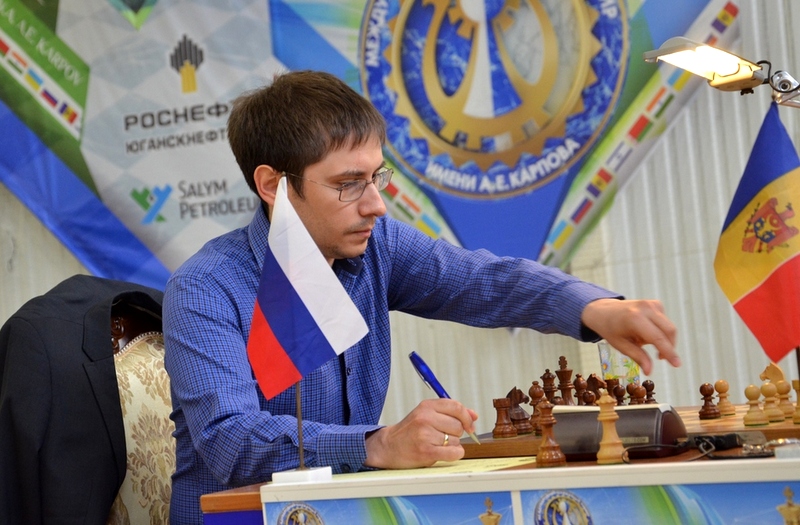


By the conclusion of the fifth round, it seemed that the tournament was unfolding to become a chase between Ian Nepomniachtchi and the rest of the pack. Since the start, either Nepomniachtchi was the sole leader or he was caught by others and jointly led. Even after round five, when he had suffered his first loss of the event, Vladimir Fedoseev, 'Neop' was jointly leading with Dmitry Jakovenko and Fedoseev.
But at the end of the seventh round, for the first time in the tournament, Nepomniachtchi has had to settle for the second place. Having won both of his last two games, it was Jakovenko who succeeded in overtaking the tournament’s top seed after Nepo agreed to a quick draw in the seventh round against Vladislav Kovalev.
Usually, after having lost a game, grandmasters tend to slow down and go on damage control mode by playing safely in the following game. But in Nepomniachtchti’s case in the sixth round of the tournament, he knew that this was his chance of scoring a point. His opponent was Victor Bologan who is having one nightmare of a tournament in Poikovsky. Out of his first five games, Bologan had lost four and drawn one. Moreover, Nepomniachtchi had the white pieces.
Bologan tried to play it safe, venturing into the Berlin wall in the hope of keeping the game balanced. But after Nepo castled queenside in the game, this was hardly going to be the case. Pawns stormed down the board on both flanks as players tried to break through to the enemy king. On his 24th turn, Bologan tried to rip open the white king with back-to-back pawn breaks but this backfired horribly. Giving up an exchange, Nepomniachtchi converted the game very easily.
A harmless looking Berlin led to a vicious middlegame in Nepomniachtchi's vs Bologan | Photo: Vasily Papin
Another important game of the round was the clash between the other two co-leaders of the tournament, Dmitry Jakovenko and Vladimir Fedoseev. Fedoseev opened with the Caro-Kann and whipped out a novelty as early as on move six. But coming out of the opening, it was Jakovenko who had the better position. Jakovenko soon won a pawn and liquidated into an endgame.
Despite his extra pawn, though, converting this endgame was no piece of cake for Jakovenko. It took him a good 70 moves to force a resignation from Fedoseev.
Jakovenko played his co-leader Vladimir Fedoseev in round 6 | Photo: Vasily Papin
Meanwhile, Boris Gelfand, after his spectacular save against Vidit Gujrathi in round five, continued his great form in the sixth round. Playing against Korobov, Gelfand found a neat bishop sacrifice that won him the black queen for a rook and a minor piece.
Korobov defended tenaciously trying to save half a point but his rook and knight weren’t able to match his opponent’s all-powerful queen. With this victory, Gelfand came within a half-point of the leaders.
Gelfand came within a half point radius of the leaders after beating Korobov in a 98-move-long marathon | Photo: Vasily Papin
Jakovenko and Nepomniachtchi were the leaders going into the seventh round and were closely followed by Boris Gelfand who was half-a-point behind. But by the end of the round, things had almost magically fallen in place for Jakovenko.
To start with, Ian Nepomniachtchi headed straight for a draw in his game against Kovalev. In a 3.Bb5 Sicilian, the two merely played 17 moves before calling it a day.
Kovalev and Nepomniachtchi settled for a quick draw in round 7 | Photo: Vasily Papin
Another important game for the standings was the one between Gelfand and Fedoseev. Had Gelfand won this one, he would have gained a serious chance at the title. The game was fairly balanced throughout and one move after the first time control was reached, peace was signed.
Fedoseev did not pose Gelfand any problems in a Bogo-Indian | Photo: Vasily Papin
Jakovenko’s own game didn’t look too promising either. He was black against Bologan in a Sicilian Taimanov and had reached an almost dead drawn endgame. But Bologan, who has been struggling badly in this tournament, blundered.
Black is threatening to take on d4 and then on e2 in this position. This could be parried easily with 44.Re1 or 44.Nxc6+ followed by Re1. But Bologan went for 44.Ba6 and now the bishop is running out of squares. Play continued 44…Nxd4 45.Kxd4 Ra2. Now if white plays 44.Bb7, 44…Ra7 pockets the piece for black. Bologan saved the piece with 44.Bd3 but after 44…Rd2 45.Rf3 Rxd3 46.Rxd3 Bxd3 47.Kxd3 the king and pawn endgame is lost by force.
Bologan's blunder propelled Jakovenko into sole lead | Photo: Vasily Papin
Jakovenko, with his win in round seven, has taken sole lead in the tournament. The only two players who could catch up with him are Ian Nepopmniachtchi and Boris Gelfand. In fact, Jakovenko is slated to play Nepomniachtchi in the final round. With just two rounds to go, the tournament is surely headed to an exciting finish.